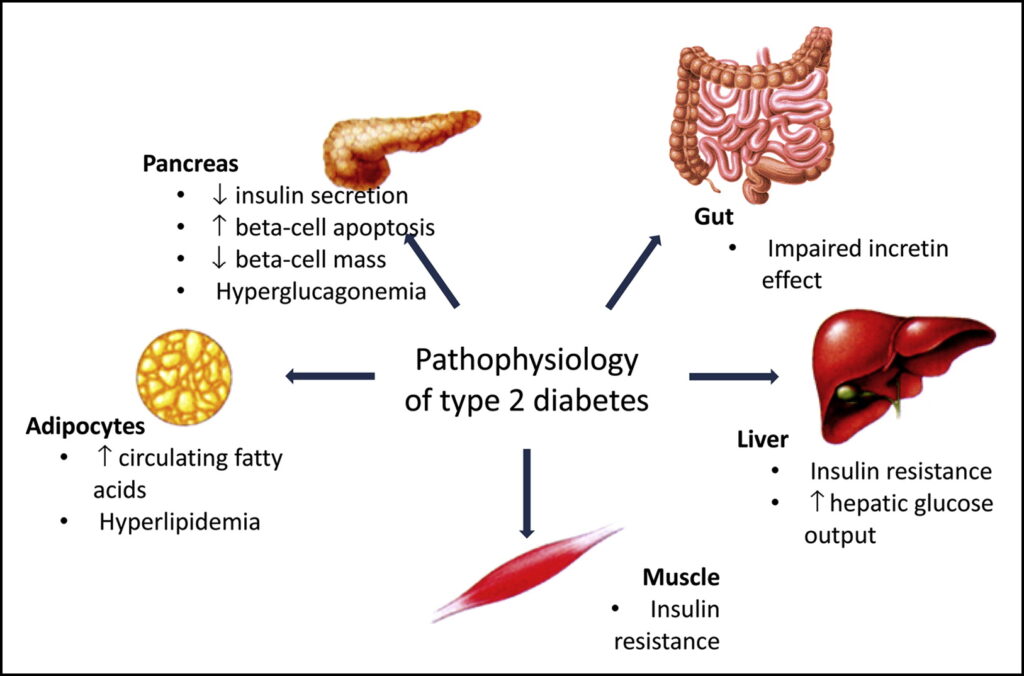Diabetes Pathophysiology
Revealing the Enigma: Deciphering the Pathophysiology of Type 2 Diabetes
Millions of people worldwide suffer with diabetes mellitus, a chronic illness that frequently changes their lives. However, what specific physiological processes result in this imbalance? Herein lies the relevance of the intriguing field of pathophysiology science. Let’s investigate the underlying causes of diabetes mellitus and learn more about its intricate mechanisms.
Table of Contents

Insulin Resistance or Deficiency is the Main Cause.
Diabetes Pathophysiology
Diabetes is mostly caused by an issue with the hormone insulin. Insulin, which is produced by the pancreas, functions as a key that opens cells and permits the entry of glucose (blood sugar), which is used to produce energy. Nevertheless, this process is hampered by diabetes:
- Type 1 Diabetes: In this condition, there is almost no insulin produced because the immune system of the body unintentionally targets the beta cells in the pancreas, which produce insulin.
- Diabetes Type 2: This variant, which is more prevalent, either:
- Insulin Resistance: Although the body may manufacture some insulin, cells grow resistant to its actions, which hinders the uptake of glucose.
- Relative Insulin Deficiency: The body becomes more and more insulin resistant, and the pancreas finds it difficult to make enough insulin to combat this.
The Chain Reaction: The Aftereffects of a Blocked Glucose Metabolism
Diabetes Pathophysiology
A cascading impact results from cells being unable to utilise glucose because of insulin resistance or insufficiency:
- Hyperglycemia: often known as high blood sugar, occurs when blood glucose levels rise above normal.
- Cellular Starvation: Cells cannot use the blood sugar that is present in excess for energy, which results in cellular starvation.
- Enhanced Glucagon Secretion: The pancreas secretes glucagon to counteract low cellular energy. This causes the liver to release stored glucose into the bloodstream, escalating the hyperglycemia.
- Metabolic Imbalance: The body experiences a number of metabolic disturbances as a result of its inability to keep proteins, lipids, and carbs in proper proportion.
The Final Cost: Diabetes Complications
Diabetes Pathophysiology
Diabetes-related chronic hyperglycemia can cause major consequences and havoc on the body over time.
- Microvascular Complications: Injury to tiny blood arteries can result in retinopathy, nephropathy, and neuropathy, which are disorders of the eyes, kidneys, and nerves.
- complications related to the heart: Peripheral artery disease, heart disease, and stroke can all be made more likely by high blood sugar.
- Slow Healing of Wounds: Damage to the nerves and impaired blood flow can prevent wounds from healing, which raises the risk of infection.
Recognising Differences: Different Diabetes Mellitus Types
Diabetes Pathophysiology
Although type 1 and type 2 diabetes are the most common types, there are additional varieties as well:
- Gestational Diabetes: Hormonal changes during pregnancy might impact insulin sensitivity, resulting in the development of this transient type of the disease.
- Monogenic Diabetes: The function or manufacturing of insulin is impacted by this uncommon class of hereditary illnesses.
- Secondary Diabetes: Diabetes-like symptoms can be brought on by specific illnesses or drugs.
A Glimmer of Hope: Early Identification and Handling
Diabetes Pathophysiology
Diabetes is complicated, but results can be greatly enhanced by early detection and appropriate care. This is the reason why:
- Frequent Blood Sugar Monitoring: Early detection of possible issues is made possible by routinely monitoring blood sugar levels.
- Lifestyle Adjustments: You can enhance insulin sensitivity and blood sugar regulation by eating a balanced diet, exercising frequently, and controlling your weight.
- Drugs: A number of drugs, such as insulin, can help control blood sugar levels and avert problems.
Diabetes Pathophysiology
We can learn vital information about the pathophysiology of diabetes mellitus and how the disease progresses. This gives us the ability to proactively work towards early detection, prevention, and efficient management, all of which contribute to a longer, healthier life.


